Best String from every Category
Best String Overall
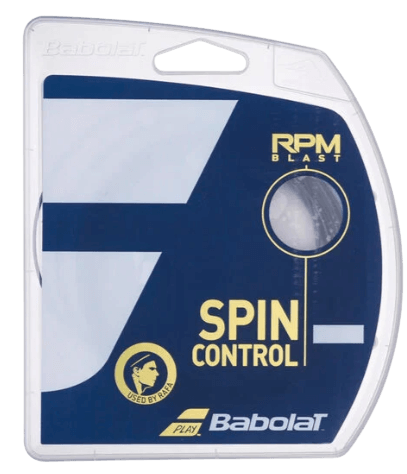
Babolat RPM Blast
- Slightly softer and easier on the arm.
- Very high control on every stroke.
- Convincing in every category (except price).
- Often very expensive depending on availability.
90
80
88
Best for Spin
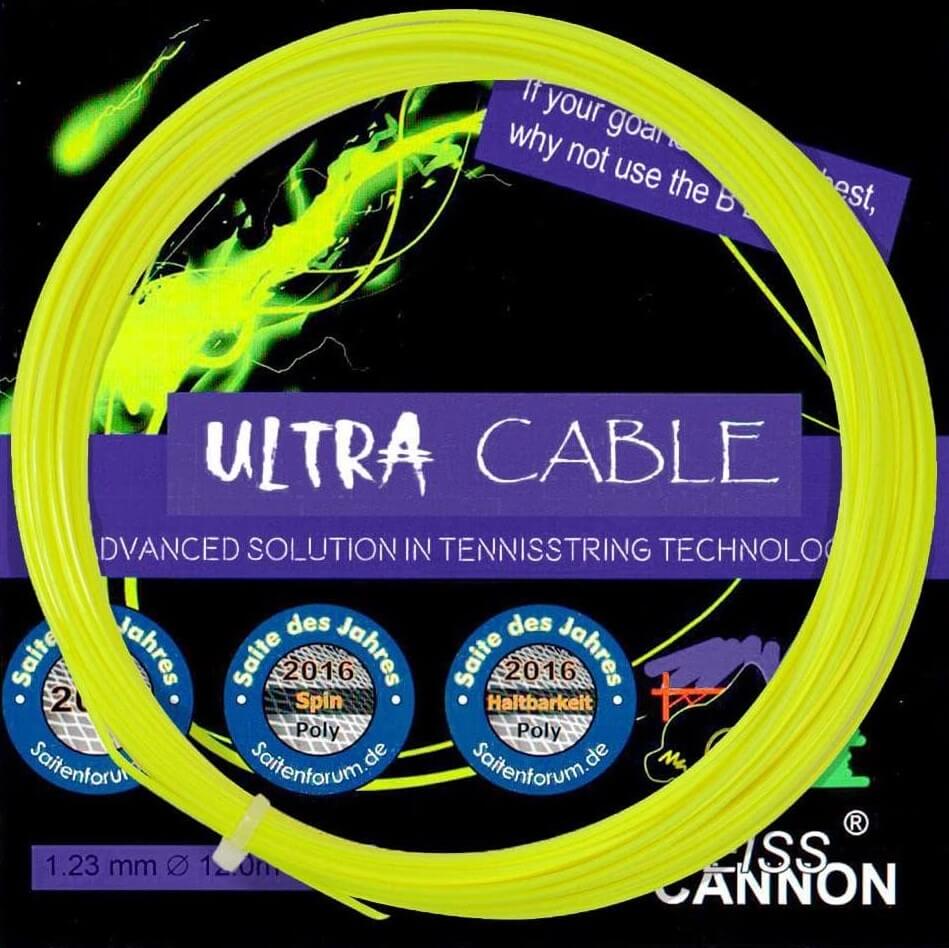
Weiss Cannon Ultra Cable
- no other string produces more spin
- Did I mention that probably no string on this planet generates more spin?
- ugly packaging
- not available everywhere
100
78
67
Best for Control

HEAD Hawk Touch
- highest amount of control
- Average performance in all other categories
- No major cons
74
70
100
Best for Power

Babolat Touch VS
- Extreme trampoline effect for plenty of power
- High quality
- Good level of spin and control despite excessive power
- One of the most expensive strings on the market
55
100
75
Best for Beginners
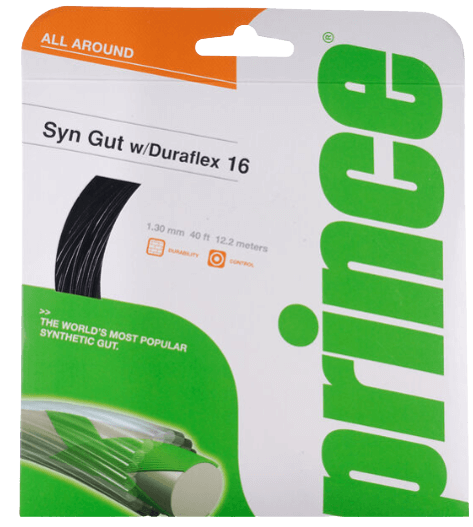
Prince Synthetic Gut Duraflex
- Very good price-performance ratio
- Good all-rounder
- Not suitable for beginners who hit very hard
55
90
69
Best Bang for Buck

Isospeed Baseline Control

- Very similar to the RPM Blast
- The best value for money of all the strings
- Frequently sold out
86
76
83
Independent & Unbiased
All products featured on FourtyLove are tested independently by me. I do not favour any brands nor do I receive any money from brands influencing my results. I might earn a small commission if you buy products through my affiliate links.
Strings Tested
Hits per String
Hours Tested
Readers
Listen to this article:
Table of Contents
4 Steps To Find Your String
1. What advantage should the string bring?
What is your playing style and how should your string support it? For example, if you play a lot of topspin, you might choose a string that increases spin even more. On the other hand, you might choose a string that improves a weakness in your game, such as power or control. You may also have frequent arm problems and want to choose a string that will help you play longer and more often without injury or pain.
2. How long have you been playing tennis?
If you are a beginner, you should choose a lighter and more flexible string that will help you control the ball better. If you are an advanced player, you should choose a harder and more stable string that will give you more power and control.
3. How often do you play?
If you play tennis only once or twice a week, you can safely choose a string that has a normal durability. However, if you play more often, you should choose a string and string gauge that increases the durability of your string so that it doesn’t break every two hours and the stringing tension is not lost so quickly. This will save you time and money!
4. What is your budget?
As with about every product in this world, you can buy tennis strings in every price range imaginable. Some of them are worth it, while for some the price-performance ratio is no longer acceptable.
All Strings compared
There are countless strings on the tennis market made of different materials with different properties. So you do not have to test all the strings, I have done this for you and created a ranking. Keep in mind, however, that many properties, such as the control of a string, are different for each player. In addition, string tension plays a big role. Less pounds on the string increases the trampoline effect and therefore what we call “power”, while more pounds increases precision. Therefore, I can only recommend that after choosing the string that suits you best, you test different stringing stiffnesses.
All Strings Compared Table
| String | Spin | Power | Control | Rating | Price/ft | Material | |
|---|---|---|---|---|---|---|---|
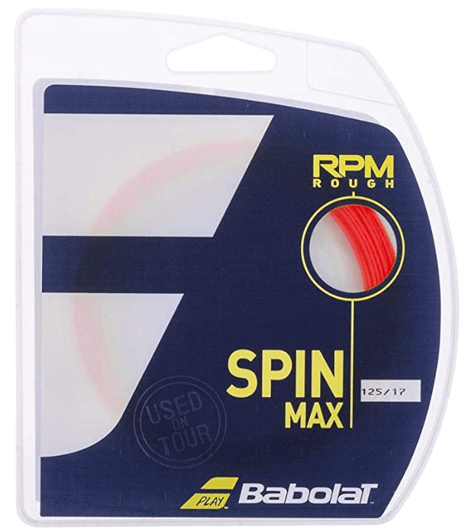 |
RPM Blast Rough See Review |
97 | 68 | 82 | 82 | 0.38 $ | Polyester |
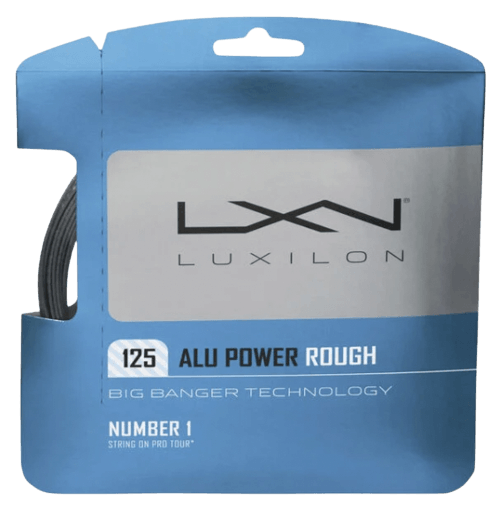 |
Alu Power Rough See Review |
91 | 64 | 84 | 80 | 0.46 $ | Polyester |
 |
Ultra Cable See Review |
100 | 78 | 67 | 82 | 0.21 $ | Polyester |
 |
Hawk Touch See Review |
74 | 70 | 100 | 81 | 0.33 $ | Polyester |
 |
Isospeed Control See Review |
86 | 76 | 83 | 82 | 0.17 $ | Polyester |
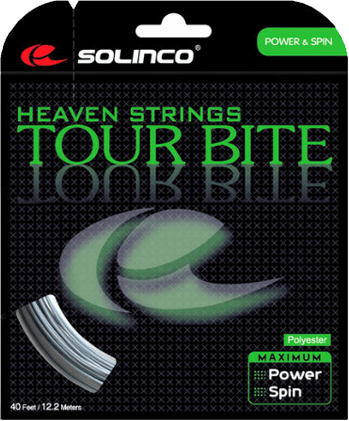 |
Tour Bite See Review |
80 | 62 | 95 | 79 | 0.26 $ | Polyester |
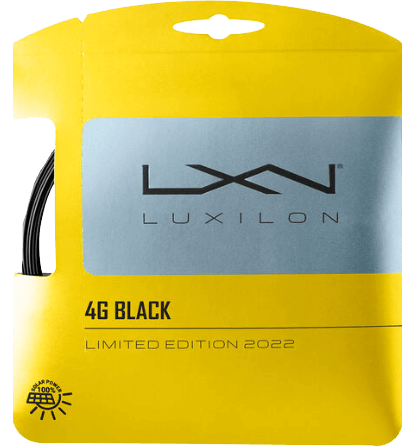 |
Luxilon 4G See Review |
72 | 52 | 95 | 73 | 0.42 $ | Polyester |
 |
Touch VS See Review |
55 | 100 | 75 | 77 | 0.85 $ | Naturdarm |
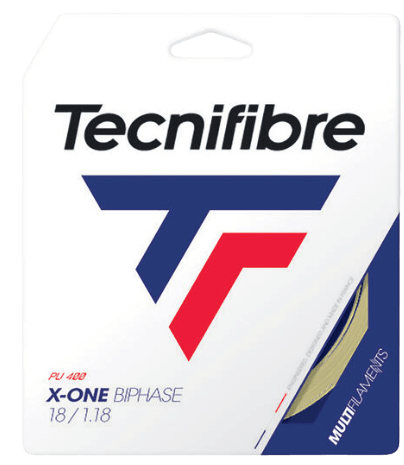 |
X-One Biphase See Review |
48 | 93 | 80 | 74 | 0.48 $ | Nylon |
 |
NXT Power See Review |
55 | 93 | 78 | 75 | 0.45 $ | Nylon |
 |
Alu Power See Review |
74 | 88 | 86 | 83 | 0.42 $ | Polyester |
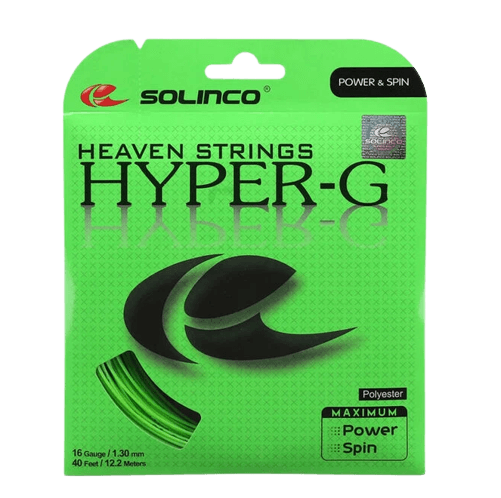 |
Hyper-G See Review |
86 | 86 | 76 | 83 | 0.26 $ | Polyester |
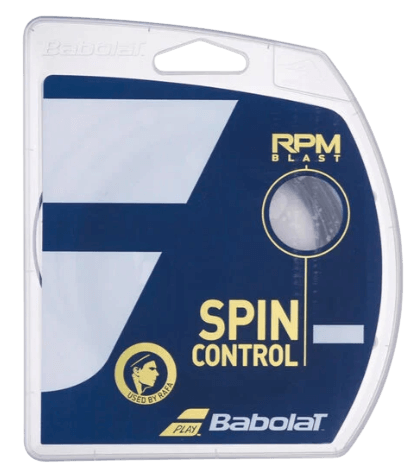 |
RPM Blast See Review |
90 | 80 | 88 | 86 | 0.39 $ | Polyester |
 |
SYNTHETIC GUT DURAFLEX See Review |
55 | 90 | 69 | 71 | 0.12 $ | Nylon |
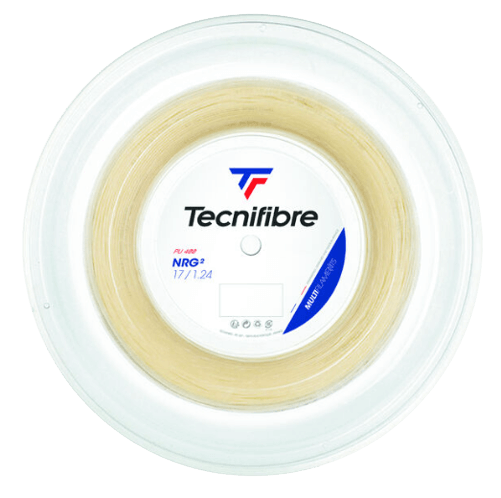 |
NRG² See Review |
48 | 86 | 69 | 67 | 0.45 $ | Nylon |
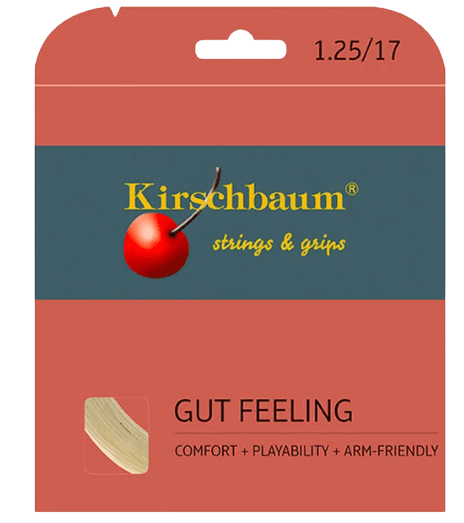 |
Gut Feeling See Review |
50 | 91 | 60 | 67 | 0.25 $ | Nylon |
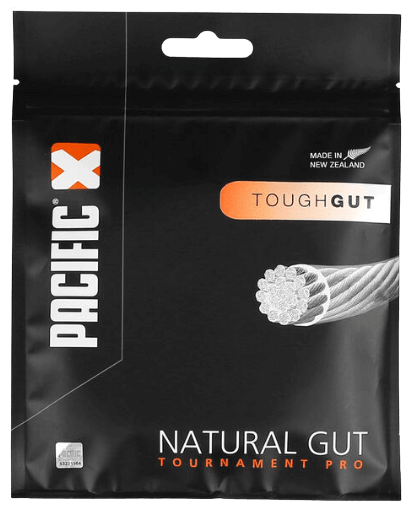 |
Tournament Pro Natural Gut See Review |
38 | 96 | 58 | 64 | 2.5 $ | Naturdarm |
THE BEST STRINGS FOR SPIN
Especially in the summer, we all play a lot on clay and that topspin is one of the dominating factors for success here, we have seen for years at the French Open. For optimum topspin, you not only need a racquet that promotes spin (if you’re looking for a new racquet, my review of current racquets will definitely help), but also a string that gives the ball more spin. So here are the best strings for topspin players:
Poly strings, because of their nature, are the best choice for a racquet string setup for maximum spin.
Babolat RPM Rough
The RPM Blast is one of the most well-known and popular strings among tennis players. This notoriety comes in large part from its ability to create a lot of spin and, of course, thrives on Rafael Nadal, whose 91% success rate on clay makes the RPM Blast look extremely good. Babolat has now brought out the Rough variant, which has even more spin! If the Luxilon ALU Power Rough and Babolat RMP Blast get married and have kids, the result would be the RPM Rough. This monofilament string made of high quality co-polyester is octagonal and roughened to create more traction with the felt from the ball. At the same time, it is very soft and delivers what it promises and already has in its name: generate rotation per minute!
The RPM Rough gets a 82/100 from me. It generates as much spin as hardly any other string, but the medal has two sides as you know ;). The excess spin decreases the control significantly compared to the RPM Blast, which forces me to give it a lower rating.
PRO
- durable due to high quality
- extrem amounts much spin
- really a lot of spin
CON
- not as much power and control as the regular RPM Blast
- Babolat RPM Price
Luxilon Alu Power Rough
Probably the best known string not named RPM Blast is Luxilon’s Alu Power. Not quite as stiff as the RPM Blast, but with the same potential for spin, this co-poly string is more comfortable on the arm from stroke to stroke. If you’ve ever played the Alu Power, you know the crisp and lively feel of the string at ball contact, which is hard to put into words. Whether you choose the Alu Power or RPM Blast should depend on the string’s feedback on impact. Both strings are great choices for spin in 2024, as they have been for the past 10 years.
PRO
- #1 string on the ATP Tour
- Lots of spin
- Lots of control in addition to lots of spin
- Durable
CON
- Less comfort than many other strings
- Expensive
Weiss Cannon Ultra Cable
Not necessarily a completely unknown string, after all it won the title of “String of the Year 2016” from Saitenforum, but still an insider tip that many don’t know about: The Ultra Cable from German manufacturer Weiss Cannon is the string that generates the most spin and that’s the end of the discussion, at least if you don’t care about any control and power for now.
The spin monster is square-shaped, monofilament and made of co-polyester. Your stringer will thank you because the Ultra Cable is extremely sharp. 🔪
PRO
- no other string produces more spin
- Did I mention that probably no string on this planet generates more spin
CON
- ugly packaging
- not available everywhere
The 3 hottest
tennis news
+ shortform, no spam, every friday 🎾
The best Strings for Control
If you’re looking for a string for control, there’s really no way around a stiff polyester string. Polyester strings are not particularly elastic, which increases control and precision. For some players the ball stays in the string very long with the Hawk Touch that it gives 100/100 control, for some players the ball stays in the string too long and they start to move and control is lost. The category “control” is a very subjective and different for each tennis player.
HEAD Hawk Touch
HEAD developed the Hawk Touch with several ATP pros, and you can also quickly tell that it’s designed for players at a high level. If you have a high hitting speed yourself, the Hawk Touch is definitely a good choice. It doesn’t generate a lot of power by itself, but it does generate a lot of control. So you get out of it what you put into it, no big trampoline effect…. The poly string is round and not square, has a good snapback effect. In my test, the string came out very well in a racquet that generates a little more power, like the Babolat Pure Drive.
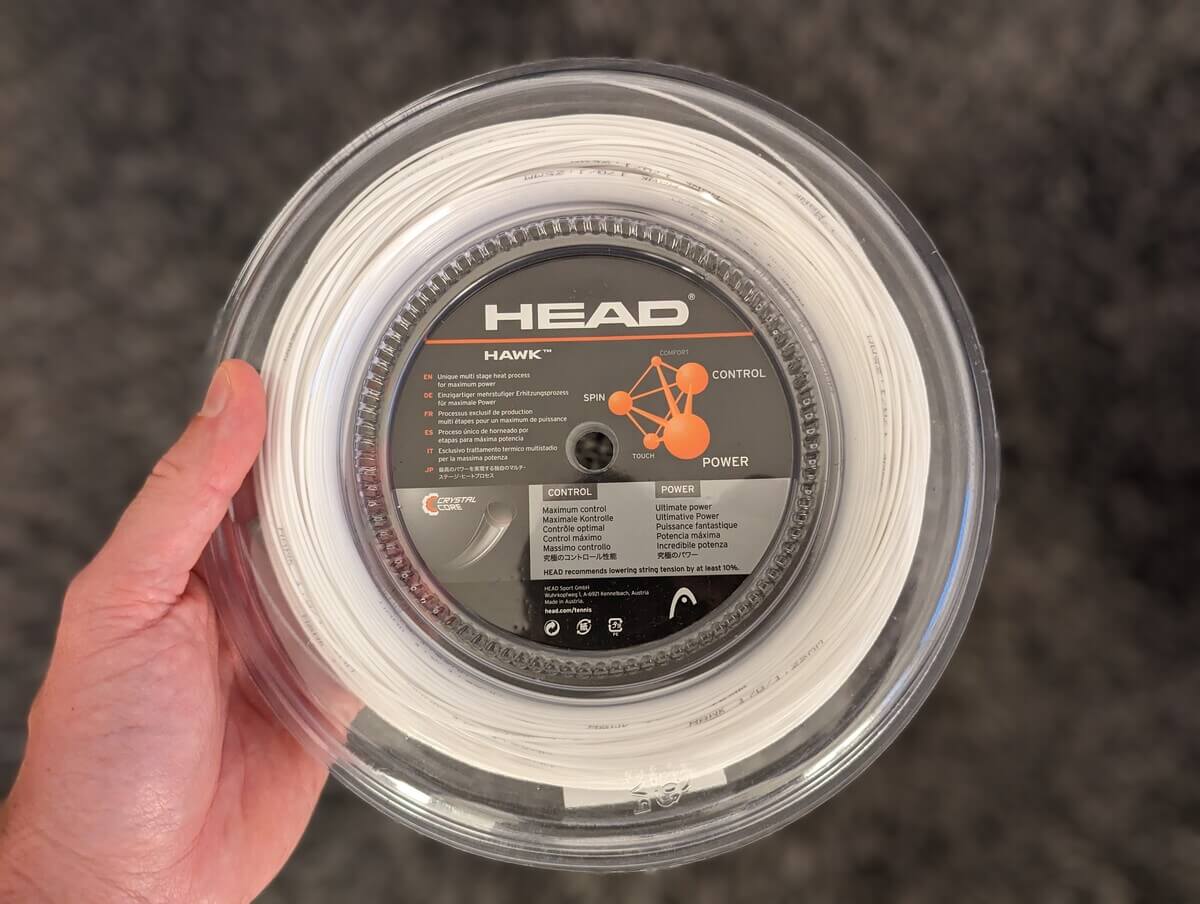
PRO
- highest amount of control
- Average performance in all other categories
CON
- No major cons
Solinco Tour Bite
For many, Solinco’s preferred string, the square-shaped Tour Bite. Made for players who want to know exactly where on the racquet they are hitting the ball. Quasi the exact opposite of the RPM Blast.
The Tour Bite is Solinco’s stiffest string, so it’s not for players who need string support to generate power. A little tip, if you plan to combine the Tour Bite in a hybrid stringing, you should definitely not choose a natural gut string as a combination, as the very sharp-edged Tour Bite, as the name suggests, will “bite” into the other string.
PRO
- Good for players who expect control with lots of spin
- Good value for the money
CON
- Too sharp-edged to combine with soft strings
Luxilon 4G
The Mercedes-Benz among string manufacturers released a very stiff poly string some time ago, which shines with much more power than, for example, the Hawk Touch or Tour Bite. I see at least one player at every tournament who combines the 4G with a Pure Drive.
PRO
- Very easy on the arm
- Luxilon quality
CON
- Very expensive
THE BEST STRINGS FOR POWER
Strings that generate a lot of power can make the game easier, especially on fast surfaces like carpet. With more speed, less precision is needed to put your opponent in a bind. Spin and control shouldn’t be completely forgotten, of course, so here are the best strings for power, but with which you’ll occasionally hit a ball down the court.
Strings that generate a lot of power can make the game easier, especially on fast surfaces like carpet. With more speed, less precision is needed to put your opponent in a bind. Spin and control shouldn’t be completely forgotten, of course, so here are the best strings for power, but with which you’ll occasionally hit a ball down the court.
Babolat Touch VS
The origin of natural gut strings and thus the inventor of a string material that has changed the string and tennis market forever. The Babolat Touch VS is virtually the great-great-grandson of the first natural gut string from Babolat and an absolute legend among natural gut string players. The Touch VS is very expensive, but also extremely high quality. It has one of the largest trampoline effects of all the strings tested, giving it the greatest potential for power and speed. Despite this amount of power, Babolat delivers a string with the Touch VS that still provides a good amount of control and spin to keep every ball from landing in the fence.
PRO
- Extreme trampoline effect for plenty of power
- High quality
- Good level of spin and control despite excessive power
CON
- One of the most expensive strings on the market
Tecnifibre X-One Biphase
The X-One Biphase is a very arm-friendly, somewhat expensive, multifilament string that plays almost like a natural gut string. The comfort over the low vibrations transmitted to the arm is really special. Definitely the softest synthetic string on the market in 2024.
PRO
- Most arm-friendly string on the market
- Lots of power
CON
- Durability not very high
Wilson NXT Power
The NXT Power is made by Wilson from twice as many fibers as the standard NXT string, making it feel very soft. Stringing tension is lost very slowly, but it breaks relatively often for hard hitters. Similar to the Touch VS, this multifilament string feels like a natural gut string. The NXT Power has been on the market for over 25 years and actually has very few drawbacks. Therefore, it is also my no-brainer choice for players looking for a power string.
PRO
- Very soft and easy on the arm
- String tension lasts a long time
CON
- Breaks quickly for hard hitters
Best Overall
In the Allrounder category you will find the strings that most players imagine to be the “best tennis strings”. They have the highest average rating in all three categories spin, power and control. You can’t really go wrong with any of these strings, as they have hardly any disadvantages and really only advantages for spin, control and power. All the strings in this category are very commonly used by advanced and even professional players.
In the Allrounder category you will find the strings that most players imagine to be the “best tennis strings”. You can’t really go wrong with any of these strings, as they have hardly any disadvantages and really only advantages for spin, control and power. All the strings in this category are very commonly used by advanced and even professional players.
Babolat RPM Blast
Probably the most famous string ever. The RPM Blast from Babolat actually speaks for itself. Extremely high control and enough spin with just the right amount of power make the RPM Blast not only the best string in my test, but also Rafael Nadal’s string.
The RPM Blast is an 8-cornered co-polyester string that holds the ball in the string for what feels like hours, bringing more control than almost any other string. Arm comfort is so high, you’d think you were playing a round co-poly with lots of spin. If you don’t hit a ball in the middle of the face, that’s no problem with the RPM Blast either, as your hits still feel good enough here, but Babolat’s bestseller still gives enough feedback for you to realize that the hit wasn’t optimal.
If you play a lot of topspin, I recommend at least a 1.30 gauge so the strings don’t move around as much. If you like to go to the net, the RPM Blast is the right string for you, because the control on volleys and the feedback are very good.
One more point is very important to me: the RPM Blast is an extremely good string for topspin players, but the amount of spin that a Rafael Nadal, for example, generates is not due to this string. There are strings, like the RPM Blast Rough, that definitely generate more spin. So don’t let the Babolat marketing fool you. The RPM Blast is an all-rounder and not a pure spin string.
PRO
- Slightly softer and easier on the arm
- Very high control on every stroke
- Convincing in every category (except price)
CON
- Often very expensive depending on availability
Isospeed Baseline Control
An absolute insider tip for an incredibly good price with performance that no other string can match for this price. The Control from the relatively unknown brand ISOSPEED is a round poly string that is modeled after a natural gut string, making it naturally very easy on the arm. In almost all categories the ISOSPEED Control plays like the RPM Blast and is therefore my recommendation if you don’t feel like spending too much for the RPM Blast but still need exactly this mix of control, spin and power. In recent years, some players have already acquired the taste (and the price) of the Control, which has led to the price going up a bit. Still, you can pretty much always save 20-30€ when buying a 200m reel compared to the RPM Blast.

PRO
- Very similar to the RPM Blast
- The best value for money of all the strings
CON
- Frequently sold out
Luxilon Alu Power
The absolute best seller from Luxilon, which you probably already know anyway: Luxilon’s Alu Power has a very unique feel that turns this poly string into a sort of synthetic gut-poly hybrid. It has a lot of power for a poly string, yet an incredible amount of control and spin. This mix makes the Alu Power one of the best strings of 2024. Compared to the RPM Blast, the Alu Power offers a bit more power than control. So if you’re looking for an incredibly good and reliable string that has a little more power, the Alu Power is exactly the right string in 2024.
The only downside to the Alu Power is the rapid loss of stringing power for advanced players. However, since they have to change strings frequently anyway, this doesn’t really make much of a difference.
PRO
- Lots of control
- Lots of spin
- Lots of power
CON
- A little harder and less arm-friendly
- Stringing tension does not last very long for advanced players
Solinco Hyper-G
The toxic green of the four-cornered Poly Hyper-G stands for aggressive spin and has a great recognition effect. The string generates quite a bit of spin, not as much as, say, the RPM Rough or Ultra Cable, but still allows you to swing with more speed as balls drop into the field more often via the large trajectory. The Hyper-G is an absolute all-rounder and is one of the best strings in every category (except price). One minor drawback is that the string may put too much strain on some players’ arms, as it is noticeably stiffer than many other strings.
PRO
- lots of spin
- more durable than most other poly strings
- good in any category
- eye-catching color
CON
- expensive
- puts a little more strain on the arm
- eye-catching color
Budget
The Baseline Control from Isospeed is the answer to what most tennis players are looking for. A string that is incredibly affordable and does not stand out negatively due to its other characteristics. To be precise, it’s the opposite. The Baseline Control stands out positively in every category and performs nearly as good as the RPM Blast while costing less than half of it. If you want to save even more dollars and have no problems with a slightly “worse” string the Prince Synthetic Gut Duraflex is your choice for the cheapest string you can find.
Isospeed Baseline Control
PRO
- Very similar to the RPM Blast
- The best value for money of all the strings
CON
- Frequently sold out
Prince Synthetic Gut Duraflex
PRO
- Very good price-performance ratio
- Good all-rounder
CON
- Not suitable for beginners who hit very hard
Best Strings for Beginners
You should get rid of the string that is already strung on your racket when you buy it as soon as possible. It has probably been on the racket for months, has already lost several kilos of stringing tension and does not suit you and your game anyway. For beginners, the following factors are important when buying a tennis string:
- The string should provide some power, but especially a lot of control.
- Since you haven’t played that much tennis yet, you should buy a string that is easy on your arm and transmits few vibrations to the frame. When you have played more, you can switch to less comfortable strings.
- Especially in the beginning, when you are still trying out a lot, make sure the string is not too expensive. You may try other strings, you don’t know your playing yet and (please don’t be angry) your technique is not yet good enough to really benefit from a “good” string. The money for this is better invested in training lessons.
Prince Synthetic Gut Duraflex
The Synthetic Gut with Duraflex from Prince is a very good allround synthetic gut string, with an excellent price/performance ratio. For most beginners, this string will be just right.
For the case that you are a beginner coming from another sport, for example, and therefore already reach a high hitting speed, you should be careful with this string, as it will break relatively quickly after all.
PRO
- Very good price-performance ratio
- Good all-rounder
CON
- Not suitable for beginners who hit very hard
Tecnifibre NRG2
From the time you feel more confident and have more confidence, a multifilament string is the right choice for a little more power. The NRG is a bit more expensive than synthetic gut strings, but will take you a step further in terms of power and spin. Again, the price-performance ratio is very good and as a beginner you won’t go far wrong with this string.
PRO
- Good value for the money
CON
- No cons
Kirschbaum Gut Feeling
Gut Feeling from Kirschbaum is a multifilament string that feels very much like a gut string. It is easy on the arm and very durable, making it very effective on the wallet. It is made using a special process by Kirschbaum, but that is beyond the scope of this test, so it adds durability and quality. The Gut Feeling is a very good alternative to the Prince Synthetic Gut Duraflex.
PRO
- Long lasting
- Abrasion resistant
- Similar to natural gut
CON
- Similar to natural Not available everywhere
The best strings for children and teenagers.
Teenagers do not need poly strings yet, but should start with natural gut for maximum arm protection. Over the following years, a slow change to poly strings should then be made. Here are my suggestions:
If money is no object, the Babolat Touch VS is the right choice. However, to save a few Euros over the course of the junior’s career, the Pacific Tournament Pro Tough Gut and Wilson Natural Gut are also very good options.
Babolat Touch VS
PRO
- Extreme trampoline effect for plenty of power
- High quality
- Good level of spin and control despite excessive power
CON
- One of the most expensive strings on the market
Pacific Tournament Pro Tough Gut
The Tournament Pro Tough Gut is a very high quality string from Pacific. It guarantees excellent energy return and precise ball control. Compared to other strings, it has a longer life and is more resistant to moisture. This string is specially designed to meet the requirements of tournament players, but is nevertheless just right for youngsters and children and supports a sensitive game. Due to its soft construction, it is also very gentle on the arm muscles.
PRO
- Resistant to moisture
- Gentle on the arms
CON
- No cons
Wilson Natural Gut
The Natural Gut from Wilson is a very good alternative to the VS Touch from Babolat. It meets all the requirements of a tennis string for kids. It is easy on the arm and generates a lot of power without the junior having to expend too much energy. The only downside, as with all natural gut strings, is the price, but that shouldn’t be a problem for a budding tennis pro.
PRO
- Lots of power with little effort
- Easy on the arm
CON
- Very expensive
- Durability not very high
To help you decide which strings to buy, we’ve put together a list of the best tennis strings for 2024. The list includes strings for spin, power and control, as well as arm-friendly options and strings that are easier on the wallet. But first, you need to know what the different string materials are and how they affect your game and the behavior of the strings:
Different types of strings
Monofilament Strings
The most important difference between monofilament and multifilament tennis strings is how they are made. Monofilament strings are made of individual filaments that are interwoven together, while multifilament strings are made of many fine filaments that are woven together.
Monofilament strings tend to offer more durability and resistance and do not break as often as multifilament strings. Players with particularly fast strokes benefit from the stability, while players with a lot of topspin benefit from the string’s good snapback effect. Monofilament strings are known for a crisp feel at impact because the string is not particularly elastic. For players with arm problems this type of string is not recommended, because the transmission of vibrations in the point of impact to the racket and thus to the arm are stronger than with natural gut or multifilament strings.
Pros and Cons of Monofilament-Stringsn
PRO
- Very stable, breaks less often
- Crisp feel
- Great snapback effect
CON
- String loses tension quickly
- Not very gentle on the arm
MULTIFILAMENT STRINGS
A multifilament string is made up of many small threads or filaments interwoven into a single string. These strings are known to provide a very soft feel when played and allow for good control and power. They are also less prone to damage than monofilament strings (strings made up of a single large fiber) and are less prone to breaking. Multifilament strings tend to be a bit more expensive than monofilament strings, but they are also more durable and tend to perform better. They are especially suited for players who value control and power and want a smooth feel when playing.
Pros and Cons of Multifilament Strings
PRO
- Soft feel
- Good control and power
- Long durability
CON
- More expensive than monofilament strings
- not as durable as natural gut strings
NATURAL GUT STRINGS
These are the oldest strings on the market. The string is made from the gut of an animal, usually a sheep. They are preferred by players who have been playing with them for a long time and offer a good mix of benefits. Natural gut strings are known for plenty of power, control and spin without really excelling in any one area. However, these strings are also the most expensive and the least durable. Therefore, many players are turning to other strings and only the purists still play racquets strung with natural gut these days. In my opinion, these will also become more and more rare in the future. Natural gut also has additional difficulties in humid conditions and often tends to break in such conditions. Natural gut strings offer a feel that no artificial string has yet been able to provide. But the technology is gradually catching on and the differences aren’t that great anymore. If you’re using natural gut strings and find that you’re breaking a lot of them, you’re probably better off using one of the other types of strings.
Pros and Cons of Natural Gut Strings
PRO
- Gentle on the arm
- very pleasant playing feeling
- holds the weight of the stringing for a very long time
- can be strung with very heavy weight
- long durability
CON
- very expensive
- susceptible to damage from moisture
SYNTHETIC GUT STRINGS
An artificial gut string is made from synthetic materials that are similar to natural gut. These strings are less expensive than natural gut strings (strings made from the gut of animals) and usually offer a good combination of control, power and durability. Synthetic gut strings are generally suitable for all playing levels and are particularly suited to players who value good performance at an affordable price. They also tend to break less than natural gut strings and are less susceptible to damage from moisture. Synthetic gut strings are available in a variety of gauges and stringing tensions and are suitable for all types of racquets and playing styles.
Pros and Cons of Synthetic Gut Strings
PRO
- good value for money
- cheapest type of tennis strings
- no damage due to moisture
- Good combination of control, power and durability
CON
- less durability than natural gut strings
- less spin than some multifilament strings
POLYESTER STRINGS
In recent years, this type of string has become popular on the market and on tour. Poly strings offer control and spin to advanced players with fast strokes. We don’t usually recommend this type of string for beginners, as poly strings are a bit stiffer.
Pros and Cons of Polyester Strings
PRO
- Breaks less often
- very affordable
- lots of spin
CON
- loses stringing tension faster
- puts more strain on the arm
HYBRID STRINGING
A hybrid stringing setup means that two different string materials are used in the main and cross string areas of the racquet. The most popular hybrid setup is natural rubber with polyester. The mains and crosses can be different materials but also different thicknesses.
Pros and Cons of Hybrid-Stringing
PRO
- Combine the advantages of both materials used
- Strings often last longer
CON
- harder to string
- often more expensive than using just one string
Ich habe jeweils die drei besten Saiten der folgenden Kategorien getestet:
Zusammenfassung
When buying your next tennis strings, make sure you do enough research. Many people spend a lot of time researching a racquet, but when it comes to strings, many just stick with the ones they’ve always used or the only ones available at their local store. String selection is much more important. Compare the different types of strings to find out which one will improve your playing the most while giving you the proper durability you need. There are so many types of strings and each one is different, so it becomes a personal thing. Make sure you use the strings that suit you and that you personally like.
Once you have the string you want in mind, you should look at the alternatives. Use our guide to help you decide which strings are best for you. It may take you some time to figure out which strings best suit your playing, but once you do, you’ll feel much better and see your playing improve to a new level, especially if you’ve been using the wrong strings for a while.
Changing strings and deciding to try something new might be the only thing your playing is missing. You’ll see an advantage, and a pretty substantial one at that, if you switch to strings that really suit you, but until you switch, you’ll never find out.
Take the leap and try out some new strings today, choose the right style and model, and watch how much your playing improves thanks to the new strings.
FREQUENTLY ASKED QUESTIONS
I answer all questions about tennis strings and stringing machines here.
Yes, strings are made from beef and sheep intestines. However, the term “catgut” or “catgut” is no longer used.
Tennis strings are made from a variety of materials, most commonly synthetic polymers such as polyester, Kevlar, or nylon. Some manufacturers also offer strings made from natural materials such as gut or cotton. The choice of material depends on the player’s preferences and the requirements for the strings. Polyester strings, for example, are particularly durable and stable, while strings made of nylon can offer a bit more power and spin. There are also hybrid strings, which are a combination of synthetic and natural materials.
String protectors are useful because they protect the strings of your tennis racquet from wear and tear. They help extend the life of the strings and ensure that you get more use out of your racquet for longer. If you play tennis regularly and want to extend the life of your strings, a string protector could be a good investment.
Multifilament tennis strings are strings that are made up of multiple filaments or threads that are interwoven together. In contrast, “monofilament” strings are made from a single thread. Multifilament strings are often considered to be especially durable and strong, as they are less susceptible to damage than monofilament strings. They also tend to offer a better feel when hitting the ball and greater control over the racquet. However, they can also be a bit more difficult to string because they have more filaments and therefore need to be strung tighter together.
Tennis strings can break for a number of reasons. One common reason is the natural wear and tear of the strings. If you play a lot and your strings are often subjected to high stress, this can cause them to break sooner. Incorrect tension or improper care of your strings can also contribute to them breaking sooner. If you severely damage your racquet, for example by hitting it on the ground or bumping it, the strings could also be damaged and break. There are also special string ripper tools that are used to intentionally break strings when you string them. These tools usually have a sharp edge that is used to cut the strings cleanly.
String tension refers to the tension at which the strings of your tennis racquet are stretched. It is expressed in pounds (lbs) or kilograms (kg). A higher string tension means the strings are tighter, while a lower string tension means they are looser. String tension affects how the racquet plays and how much control you have over the ball. A higher string tension usually offers more control, while a lower string tension offers more power and spin. The ideal string tension depends on the player’s preferences and playing style. It is important to check string tension regularly to ensure it is in the optimal range.
The manufacturing of tennis strings is a complex process that requires the use of various machines and techniques. First, the raw materials, such as polyester threads, are gathered into a pile and then put into a spinning machine where they are spun to achieve the desired thickness and strength. The threads are then interlaced in a machine to achieve the desired mesh structure. The strings are then formed under pressure and high temperatures to fix them and stabilize their shape. Finally, the strings are tested to ensure they meet quality standards and then packaged and shipped. Depending on the material and desired characteristics of the strings, the manufacturing process may vary slightly.
Stringing hardness refers to the strength or tension of the string used to string a tennis racket. A higher stringing tension means that the string is more tightly strung and yields less, while a lower stringing hardness means that the string is softer strung and yields more. Stringing tension can have a big impact on playing and can vary from player to player. Some players prefer a higher stringing tension as this offers more control, while others prefer a lower stringing tension as this offers more power and comfort. Stringing hardness can be expressed in pounds (lbs) or in newtons (N). The conversion from pounds to newtons is as follows: 1 pound = 4.448 newtons.
The life of tennis strings depends on many factors, including the quality of the strings, how often they are played, and how they are played. In general, good quality strings last longer than inferior strings. Estimating the average life of tennis strings can be difficult because it depends on so many factors. Some tennis players may change their strings every few months, while others may keep them for a year or more.
Yes, choosing the right tennis strings can make a difference when it comes to optimizing racket play and performance. The strings on a tennis racket can help affect the control, spin and power a player has when hitting the ball.
There are many different types of tennis strings on the market, which can vary in terms of material, thickness, texture and other characteristics. Choosing the right strings can help tailor the racquet’s performance to a player’s needs and preferences. For example, thinner strings can provide greater control, while thicker strings may give more power. Some strings are also specifically designed for players with high or low swing weights to optimize the racquet’s playability.
The color of tennis strings usually doesn’t matter in terms of performance or playing characteristics. Most tennis strings are available in white, black or gray, although strings in other colors are available. The choice of tennis string color is usually a matter of personal taste or player preference. Some players may prefer certain colors because they match their racket or tennis clothing better, while other players may simply choose the color they like best. However, there are also some cases where the color of the tennis strings can be important for game performance, such as strings with special coverings or coatings that may have a specific color.
Yes, tennis strings have a limited shelf life and will eventually need to be replaced. The durability of strings depends on several factors, such as the material they are made of, how often you play, and how well you take care of your racquet. As a rule, tennis strings last about 3-6 months if you play regularly. If you use your racquet less frequently, the strings may last longer. If you notice that the strings of your racquet are worn or feel loose, you should consider replacing them. It’s also important to check the string tension regularly and adjust it if necessary to extend the life of the strings.
Yes, it is possible to recycle tennis strings. Some manufacturers offer special recycling programs for old strings, where the strings are collected, shredded and made into new products. There are also organizations that specialize in recycling tennis strings and collect strings from the various manufacturers.
Recycled tennis strings can be used in a variety of products, such as shoes, bags, seat cushions, and even tennis balls.
No, as a rule, tennis stringing machines are not suitable for use in stringing badminton rackets. This is because tennis and badminton rackets are different in terms of size, weight and string tension. Tennis rackets usually have larger head size and are heavier than badminton rackets, and the string tension of tennis rackets is usually higher than that of badminton rackets. Therefore, tennis stringing machines are generally unable to support the lower string tension and smaller head size of badminton rackets. To string a badminton racket you need a specific stringing machine for badminton rackets.
Choosing the right tennis string depends on your preferences and playing style. Consider the material, thickness and mesh structure of the string as well as the string tension. Try different strings or ask a coach or experienced player for advice.
Professional tennis players usually use high-quality strings designed specifically for their needs. The strings they use depend on their preferences and playing style. Some pros prefer strings made of synthetic polymers like polyester or Kevlar, while others prefer natural materials like gut or cotton. Some pros also prefer hybrid strings, which are made from a combination of synthetic and natural materials. An example of such a string is the Luxilon ALU Power Rough.
The stringing tension you should use depends on your preferences and playing style. There is no “right” or “wrong” stringing tension that will suit all players. Some players may prefer harder stringing, while others may prefer soft stringing.
As a rule of thumb, you can use the following values as a guide:
For polyester stringing, the stringing should be around 55 lbs.
For nylon coverings, the recommended stringing tension is around 60 lbs.
The stringing tension refers to the tension with which the strings are strung on the racket. A harder stringing means that the strings are more tensioned, while a softer stringing means that the strings are less tensioned. A harder stringing may help the racket give more power and control, while a softer stringing may allow for more comfort and spin.
A broken tennis string can sometimes cause scratches on the frame of the racket. However, cutting is not usually necessary, but it does speed up the stringing process because the stringer has to remove the string.
Yes, it is normal for tennis strings to move when they are strung. This is due to the elasticity of the strings and is also known as “string movement”. String movement can affect the way the ball bounces off the racquet and has an impact on the player’s control and stroke.
String movement is also dependent on the type of strings used. Strings with higher elasticity will generally produce more “spin” as they move more and contact the ball longer, while strings with lower elasticity will produce less spin but provide more control.
There are a few factors you should consider before deciding whether to buy a tennis stringing machine:
1. frequency of tennis play: if you play tennis frequently and want to restring your racquets regularly, it might be worth your while to buy a tennis stringing machine, as it can save you time and money. If word gets out in your tennis club that you are stringing rackets, you will certainly be able to restring between 5 and 10 rackets each week and will quickly recoup the money spent on the stringing machine.
2) Cost: Tennis stringing machines can be expensive, especially high end models. Make sure you look at the price/performance ratio and decide if it makes sense for you to invest in a stringing machine.
Space requirements: Tennis stringing machines usually take up a lot of space and are not very portable. Consider whether you have enough space in your home to store and use a stringing machine.
Overall, whether buying a tennis stringing machine makes sense for you depends on your individual needs and preferences. It may be worthwhile to seek advice from professional stringers and compare different options before making a decision.
Yes, you can string squash rackets with tennis strings. However, there are special squash strings that are designed for the high stresses of squash. These strings are usually stronger and more durable than tennis strings. So it may or may not be worth it to use special squash strings to extend the life of your racquet.
There are a few signs that it’s time to change the strings in your tennis racquet:
The strings are visibly damaged or broken.
The strings have lost their tension and the racquet feels “soft”.
You have difficulty controlling the racquet or playing the balls with the desired precision.
You play frequently and the strings have worn out.
As a rule, tennis strings should be changed every 6-8 weeks if you play regularly. If you play less frequently, the strings can last longer. However, it’s always a good idea to check your strings regularly and change them as needed to ensure the best possible playing experience.
A tennis string damper is a small piece of rubber or silicone that is attached to the ends of the strings to reduce the shock that occurs when the ball hits the strings. Dampers are often used by players who have sensitive wrists or who prefer a more comfortable feel. They are also useful if you play on hard courts, as they can help reduce the shock that is transmitted to your joints. Some players also believe that dampeners can help control the ball better. You can easily attach them to the ends of the strings by pulling them over the strings and squeezing them in the middle.
Rafael Nadal currently (2024) uses the Babolat VS Touch string in a gauge of 16g (1.30 mm). In the past he used the Babolat Pro Hurricane Tour. These strings are made of a special material called “Teflon,” which is known for its glide and is said to help increase spin. Nadal usually prefers strings with a higher gauge because they offer more stability and control, especially with his aggressive style of play.
Yes, you can string a tennis racket at home as long as you have the necessary tools and materials. Some space is needed for a stringing machine and the knowledge of how to string a racket.
Yes, that is usually the case. A higher stringing tension means that the string pressure in the racquet is higher, which in turn means that the string yields less when it is hit. This can result in the ball being played with less spin, which in turn means more control. A lower stringing tension, on the other hand, means that the string gives more when it is hit, which can result in the ball having more spin and therefore more power. However, the effect of stringing tension on control and power also depends on other factors such as the shaft of the club, the swing style of the player and the ball, so it is difficult to make general statements. It is therefore advisable to test different stringing stiffnesses to find out which one suits you best.
Tennis strings are manufactured in different parts of the world, depending on which company produces them. Some well-known manufacturers of tennis strings are:
Babolat (France)
Luxilon (Belgium)
Solinco (China)
Tecnifibre (France)
Wilson (USA)
These manufacturers produce their strings in their own factories or in collaboration with other companies in different parts of the world. There are also many smaller companies that manufacture tennis strings. The production of tennis strings is a complex process that requires the use of special machines and materials. There are different types of strings made from different materials, such as natural gut, synthetic fibers, and metal fibers, and each material requires a different manufacturing process.
There are two ways you can check the stringing tension of your tennis racket:
1. use a string tension tester. This is a small device that you can attach to the strings to measure their tension. There are several models on the market that vary in accuracy.
Play with the racket and pay attention to the feeling you have when hitting the ball. A racket with higher stringing tension will have a harder feel, while a racket with lower stringing tension will have a softer feel. Note, however, that this method is not very accurate and you may need a little experience to really feel the stringing stiffness.
The thickness of a tennis string depends on several factors, such as your playing style, your preference for control or power, and your individual preference. In general, there are four main categories of string thickness:
Thin (17g and thinner): These strings offer more power and are better suited for players who have a heavy swing and want to generate a lot of spin. However, they are less stable and can wear out more quickly.
Medium (18-20g): These strings are a good choice for most players, as they offer a good balance between power and control. They are also more durable than thinner strings.
Thick (21-23g): These strings offer more stability and control, but are less powerful than thinner strings. They are well suited for players who prefer precise placement.
Very Thick (24g and thicker): These strings offer the most stability and control, but are less powerful than thinner strings. They are best for players with slower swings or those who have particularly sensitive joints.
It’s best to try different string gauges and find out which one works best for you. You should also keep in mind that racket stringing stiffness and string gauge interact with each other and that they both have an impact on playing performance.
Tennis rackets are usually strung by professional racket fitters. Racket fitters are experts who are specially trained to string and adjust tennis rackets to optimize them for the individual player. They have specialized tools and knowledge to accurately adjust the tension of the strings and ensure that the racket is properly balanced. There are also many tennis clubs and retail stores that employ racket fitters to string rackets for their customers. It is possible to string the racket yourself, but it requires special tools and expertise and can be difficult to accurately adjust the tension of the strings. It is usually best to have the racket strung by a professional racket fitter.
There are a few reasons why you should pre-tension tennis strings:
1. pre-tensioning improves control: a pre-tensioned string provides less clearance and yields less when the ball is hit. This can help the ball to be played with less spin, offering more control.
2. pre-tensioning can increase the durability of the string: A pre-tensioned string is less susceptible to stretching and deformation, allowing it to last longer.
3.Tensioning can improve hitting comfort: A pre-tensioned string can provide a harder feedback, which can be more comfortable for some players.
However, there are some disadvantages to pre-tensioning strings:
1. pre-tensioning can reduce power: a pre-tensioned string offers less play and yields less, resulting in less ball acceleration and therefore less power.
2. pre-tensioning can reduce hitting comfort: a pre-tensioned string can provide harsher feedback, which can be uncomfortable for some players.
Therefore, it is recommended to test different biases to find out which one suits you best.
There is no clear “best” tennis string, as the choice of strings depends on many factors, such as your playing style, your preference for control or power, and your individual preferences. However, there are some strings that many players find to be particularly well-suited and are therefore popular. Some of these strings are very good in a specific category, while “the best” tennis string usually means the string that works very well in all categories, making them the most popular strings on the tennis market. The best strings in this all-rounder category are:
1. Babolat RPM Blast: The most popular string on the market. 8-sided and with a lot of a good mix of power and control and the extra spin you would expect from Rafa’s string.
2. Solinco Hyper-G: The poison green string for players who want to play one of the best all-rounders with extra power.
3. Luxilon Alu Power: Very high quality all-rounder with extra power and control for players with a high income or backers💸.
RPM Blast is an all-rounder string for players who play a lot of topspin. Strings similar to RPM Blast in these characteristics:
1. Luxilon ALU Power Rough
2. Solinco Hyper-G
3. Völkl Cyclone
Tennis strings move when the tennis ball is hit against them or when the racket hits the ball. The movement of the strings is caused by the transfer of energy from the ball or racket. The strings vibrate when they are hit by an impacting object, and these vibrations can cause the ball to bounce in a different direction. The movement of the strings can also help change the spin of the ball, which in turn can affect the trajectory of the ball.
Strings similar to Hyper G:
1. Luxilon ALU Power Rough
2. Babolat RPM Blast
Strings for advanced players and professionals often offer more control than power, as these players are physically very fit and can generate a lot of power on their own. Strings that offer a lot of control with enough spin:
1. HEAD Hawk Touch
2. Solinco Tour Bite
3. Luxilon 4G
Tennis elbow is an overuse injury to the arm that can result from repetitive tennis serves. There is no specific tennis string that can help with tennis elbow, but there are some things you can consider to minimize the risk of tennis elbow:
1. use a string gauge that is appropriate for your playing style and preference for control or power. A string gauge that is too tight or too loose can lead to increased strain.
2. choose a string construction that offers more power and control. Multifilament strings (strings made up of several smaller fibers instead of a single large fiber) usually offer more power and control than monofilament strings and can reduce stress on the arm.
3. play with a racquet grip that is appropriate for your hand size and preference for a tighter or looser grip. An incorrect racquet grip can lead to increased stress on the arm.
Use string dampening to reduce string vibration. Dampening systems such as Wilson’s Vibration Dampening System (VDS) can reduce arm stress by reducing string vibration.
5) Make sure your tennis elbow has enough time to heal. If you have tennis elbow, you may want to take a break from tennis to give your arm time to recover.
Tennissaiten mit dem größten Spinpotential:
1. Weiss Cannon Ultra Cable
2. Luxilon ALU Power Rough
3. Solinco Hyper-G
As a rule, monofilament strings (strings that are made of a single large fiber) are suitable for beginners because they are easier to string and offer more control than multifilament strings. Some popular monofilament strings for beginners are:
1. Prince Synthetic Gut Duraflex
2. Tecnifibre NRG2
3. Cherry Gut Feeling
There is no clear “best” or most durable tennis string, as durability depends on many factors, such as your playing style, how often you play, and your individual preferences. However, some strings are generally known to be more durable than others. For example, multifilament strings (strings that are made up of several smaller fibers instead of a single large fiber) are generally more durable than monofilament strings because they are less susceptible to damage. Some popular multifilament strings are:
1. Luxilon ALU Power Rough
2. Solinco Tour Bite
3. Tecnifibre X-One Biphase
The gauge of tennis strings plays an important role in the performance and feel of the tennis racket. Thicker strings usually provide more control, while thinner strings provide more power and forgiveness. However, it also depends on what type of player you are and what your racket requirements are. Professional players often prefer thinner strings, while beginners and intermediate players often prefer thicker strings for more control. It is important to match the thickness of the strings to your needs and abilities.

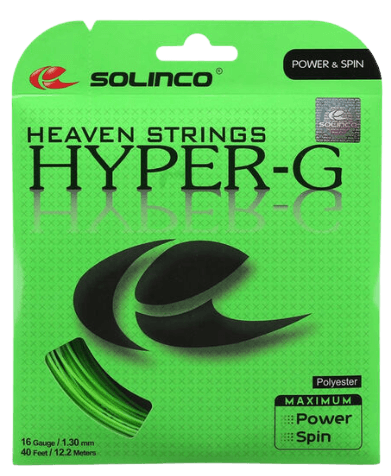
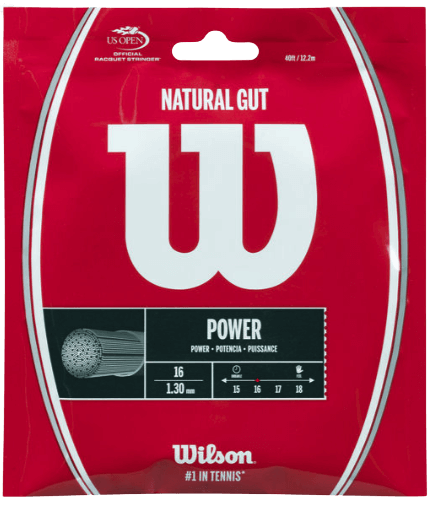
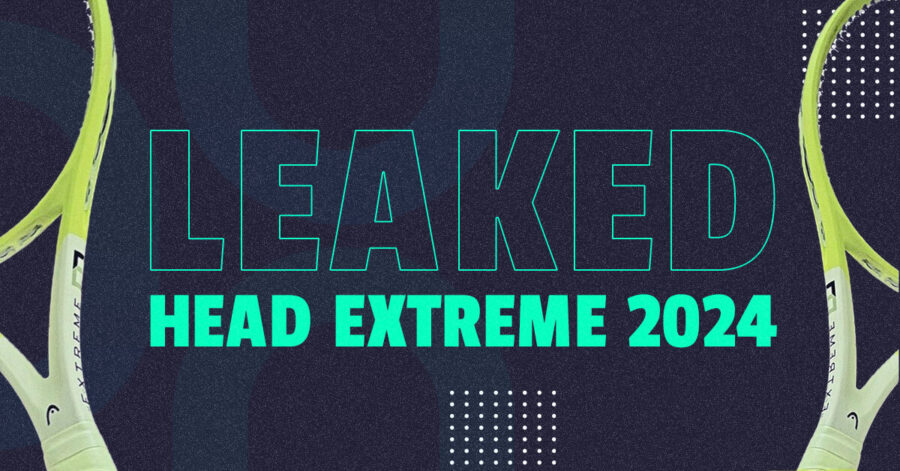
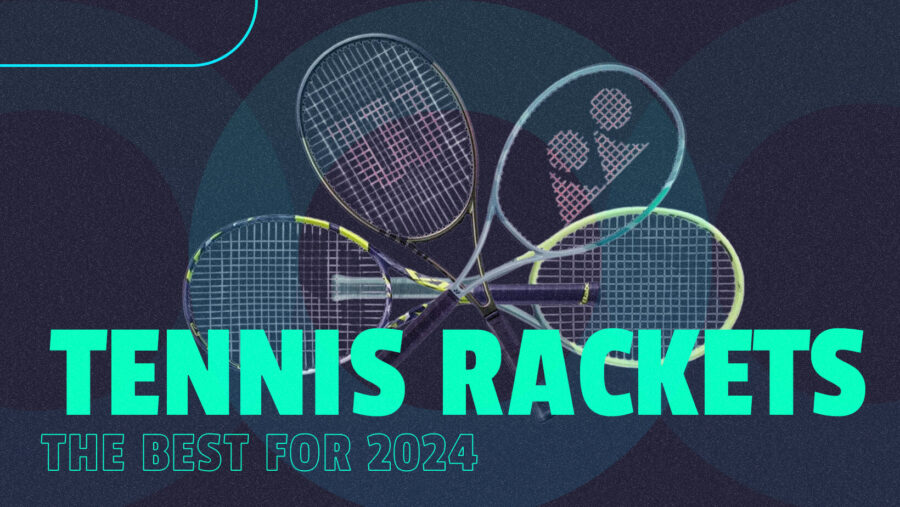
Comments